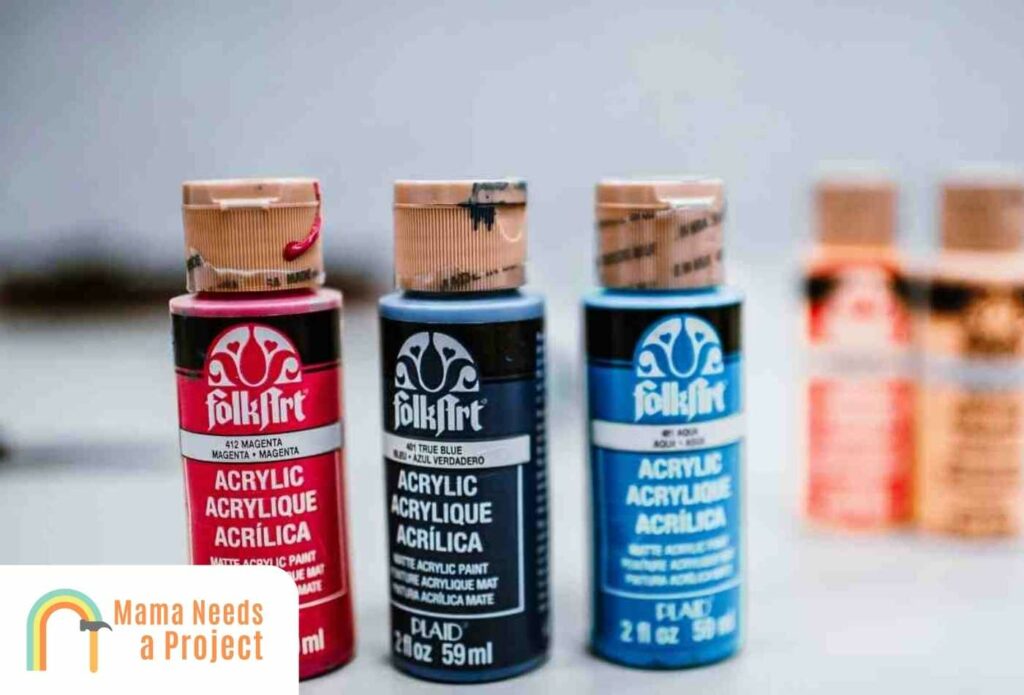How to Clean Acrylic Paint Brushes (Step by Step Guide)
Painting with acrylic paint is a fun and exciting hobby, but what do you do with your brushes when you are done painting?
In this post, I’ll take a deep dive into how to clean acrylic paint brushes the right way so you can spend less time cleaning and more time painting. Let’s dig in!
- To clean acrylic paint brushes, start by removing any wet paint from the brushes. You can then use a cleaning solution like dish soap to remove any remaining paint. Finally, let the brushes dry completely before storing them.
- Always clean your brushes immediately after use to make your job easier.
- If you need to remove dried paint, you might need to use a more abrasive cleaner.
How to Clean Acrylic Paint Brushes

1. Remove Excess Paint from the Brushes
First, you do NOT want to let acrylic paint dry on your brushes. It’s much more difficult to remove the dried paint than it is wet paint, so try to remove any excess paint on your brush as soon as possible.
After you are done painting, take a paper towel or two and wipe off any excess paint that is leftover on your brush. This will help reduce the number of times you need to rinse the brush later on. The more paint left on the brush, the longer it will take to clean it thoroughly so this is key.
2. Rinse with Water
Fill a bowl, cup, or small bucket with cold water.
Place your brush bristles in the water and move the brush in a circular motion. This will help water get between the bristles and start to loosen the stubborn paint.
Take another dry paper towel and wipe off any paint that came loose during the rinsing process.
Place the brush back into the water and let it sit. This will keep the paint wet so it won’t dry while you complete the next step.
3. Create a Cleaning Solution
There are several types of acrylic brush cleaner options that I’ll explore below. For this step, you can use any of the solutions.
Mix or prepare the cleaning solution of your choice. For this example, we will use a basic dish soap and cold water mixture.
Grab another bowl, cup, or small bucket and fill it with cold water. Next, add several drops of dish soap and stir to combine to create soapy water. You can always add more soap if needed.
4. Swish the Brush in the Soapy Water
Take brushes out of the first bowl and place the bristles of the brush in the soapy water mixture. Start to swish the brushes around, agitating the water to loosen the acrylic paint.
Do this for at least one minute. Pull the brush out of the water and wipe it with a clean paper towel.
5. Rinse with Water Again
Place the brush back into the first bucket (non-soapy water) and move it in circular motions to rinse the bristles of the brush.
6. Repeat Swishing and Rinsing Till the Brush is Clean
Continue placing the acrylic brush in the cleaning solution and then rinsing it in the non-soapy water until the brush is clean when you wipe it with a clean paper towel.
This will take several rounds of cleaning and rinsing, depending on how much paint clings to the brush bristles.
If you’re still having trouble removing dried paint from your brush, you might need to break out a fine tooth comb to break up the dried paint so it can be removed.
7. Allow the Brush to Dry Completely
You may think this is an unimportant step, but let me tell you, it’s pretty crucial that you dry your brushes properly!
If you let the dry bristles down in a cup or holder, the bristles can dry out of shape, which can be challenging to fix. On the other hand, if you dry them with the bristles facing up, the water and moisture will run down into the part of the brush that houses the base of the bristles. This moisture can ruin the glue that holds the bristles in place. So what do you do?
It is best to lay your paint brushes flat (horizontally) and allow them to dry completely before placing them in a holder or container.
Check out this post to learn how to remove acrylic paint from wood!
What Liquid Is Used to Remove Acrylic Paint from Brushes?
You might be wondering, “What are the other acrylic brush cleaners that you mentioned earlier?” – here are your options.
Liquid Brush Cleaner
Several companies make liquid brush cleaners. One of the most commonly used cleaners is Newton brush cleaner. This cleaner is non-toxic, biodegradable, and safe for natural or synthetic brushes.
These will work on both natural and synthetic brushes to remove acrylic paints.
Check out the video below for more help cleaning your brushes!
Solid Brush Cleaner Bar
Many painters like to have a solid form cleaner. An industry favorite is Masters brush cleaner. This cleaner can be used on several different paint types and is an all-in-one paint brush cleaner and preserver.
Hand Soap
Hand soap is another option if you don’t have dish soap on hand. You can use it the same way I described to use dish soap to remove acrylic paint from brushes, but I’ve found that it’s slightly less effective than dish soap.
Dish Soap
Dish soap is popular because it is easy to find, inexpensive, and works great for removing particularly stubborn paint. Plus, you probably already have it on hand!
The only downside is that I’ve found it can be too rough on some paintbrush bristles.
Hand Sanitizer
If you do find yourself with dry, stubborn paint on your brushes, here’s a fun little trick.
Take some hand sanitizer and put a generous amount in the palm of your hand. Next, place the brush bristles in the sanitizer. Let it sit for about a minute.
Next, rub the bristles between your fingers, allowing the sanitizer to penetrate the bristles and loosen the paint. This will soften the paint and make it easier for you to clean them.
Acetone
Did you know you can also use acetone to remove dry acrylic paint?
Many people have a bottle of acetone lying around at home, and it works great for breaking down dried acrylic paint.
Pour a small amount of acetone into a small cup and place the brush bristles into the acetone. Let it sit for a few minutes, rinse, and repeat if you still have more paint buildup stuck on the brush.
Ensure you’re working in a well-ventilated area since acetone has a strong odor. Use gloves when handling the brushes that touch acetone since acetone can dry out your hands.
Check out these ways to clean a polyurethane brush!
Tips for Cleaning Acrylic Paint Brushes
1. Always Clean Them Right Away
I briefly mentioned it earlier, but you really want to wash your acrylic paint brushes immediately once you’ve finished painting. Once the paint starts to set and harden, it can be a real hassle to clean them off without damaging your brush in the process.
If you need to wait to clean them, place the bristles down in a shallow cup of cold water. Don’t leave them like this for more than a couple of hours.
2. Always Use Cold Water
Cold water is key when cleaning acrylic brushes.
If you use warm or even hot water, you risk the potential for the paint to start to set and “gum up” your brushes. This can make it quite tricky to clean them.
3. Don’t Leave Them To Soak Overnight
Soaking the bristles too long can cause them to “splay out” and lose shape. It can also lead to moisture soaking up into the ferrule of the brush (the area where the bristles are glued together.) That could ruin the brush – which nobody wants.
4. Don’t Rinse the Dirty Paint Water Down the Drain
It may seem like the easiest way to get rid of the dirty water, but over time, the paint residue can build up and cause issues in your plumbing.
Instead, let the container of dirty water sit overnight. The paint residue will settle to the bottom of the container. Then you can pour the water from the top of the container and wipe out the paint residue with a paper towel.
Throw away the paint-covered paper towels in your regular trash.
FAQs
Can You Use Dawn Dish Soap To Clean Acrylic Paint Brushes?
Yes! Dawn dish soap is a popular choice you can use to clean your brushes. A couple of reasons it’s so widely used are because it’s easy to find and it’s safe to use without wearing protective gloves or masks. Dawn is also an excellent choice for cleaning oil-based paints.
Can I Use Vinegar to Clean Acrylic Paint Brushes?
Vinegar is used for all kinds of cleaning solutions, so it makes sense to use it for acrylic paint, right? Right!
You can use vinegar for cleaning acrylic brushes just like you would with hand sanitizer. Get some white vinegar in your hand and rub the bristles between your fingers with the vinegar.
Make sure you rinse the brushes thoroughly with cold water to remove any residual vinegar. This is a great non-toxic option to clean paint brushes.
Does Rubbing Alcohol Remove Dried Acrylic Paint?
There’s nothing more frustrating than finishing a painting and realizing you got a splotch of paint on your clothing. But how can you remove acrylic paint from fabric?
Rubbing alcohol (aka isopropyl alcohol) can remove acrylic paint from all sorts of surfaces, including fabric. You can also use denatured alcohol if you have that on hand. Rubbing alcohol acts as a solvent when it touches acrylic paint.
All you need to do is soak your brushes in the alcohol for a few minutes to remove acrylic paint, wet or dry, from your acrylic paintbrushes.
Is It OK to Clean Acrylic Paint Brushes in the Sink?
It is not recommended to clean acrylic brushes in the sink since the acrylic paint can cause plumbing problems over time. Instead, try to clean your brushes in a bucket, cup, or bowl so you can keep the paint solids out of your plumbing. When you’re finished, you can pour the water down the sink and wipe the paint with paper towel.
Final Thoughts
Acrylic painting is a fun medium for creativity, but there’s no doubt it can be messy – especially when it comes to cleaning your brushes.
To clean an acrylic paint brush you can use water, dish soap (or another cleaning solution), and some scrubbing to remove the paint.
Always clean your brushes as soon as you’re done using them and let them dry before storing them away.

Miriam Ronne wears many hats, including but not limited to freelance writer, blogger, professional quilter, serial DIYer, and obsessed dog mom. She loves to teach beginners how to do all sorts of crafts and techniques. If she’s not writing her next blog post, she’s either sewing a new project or playing with her pup. You can find Miriam on her blog, Stitch Obsessed, or connect with her on Instagram.

